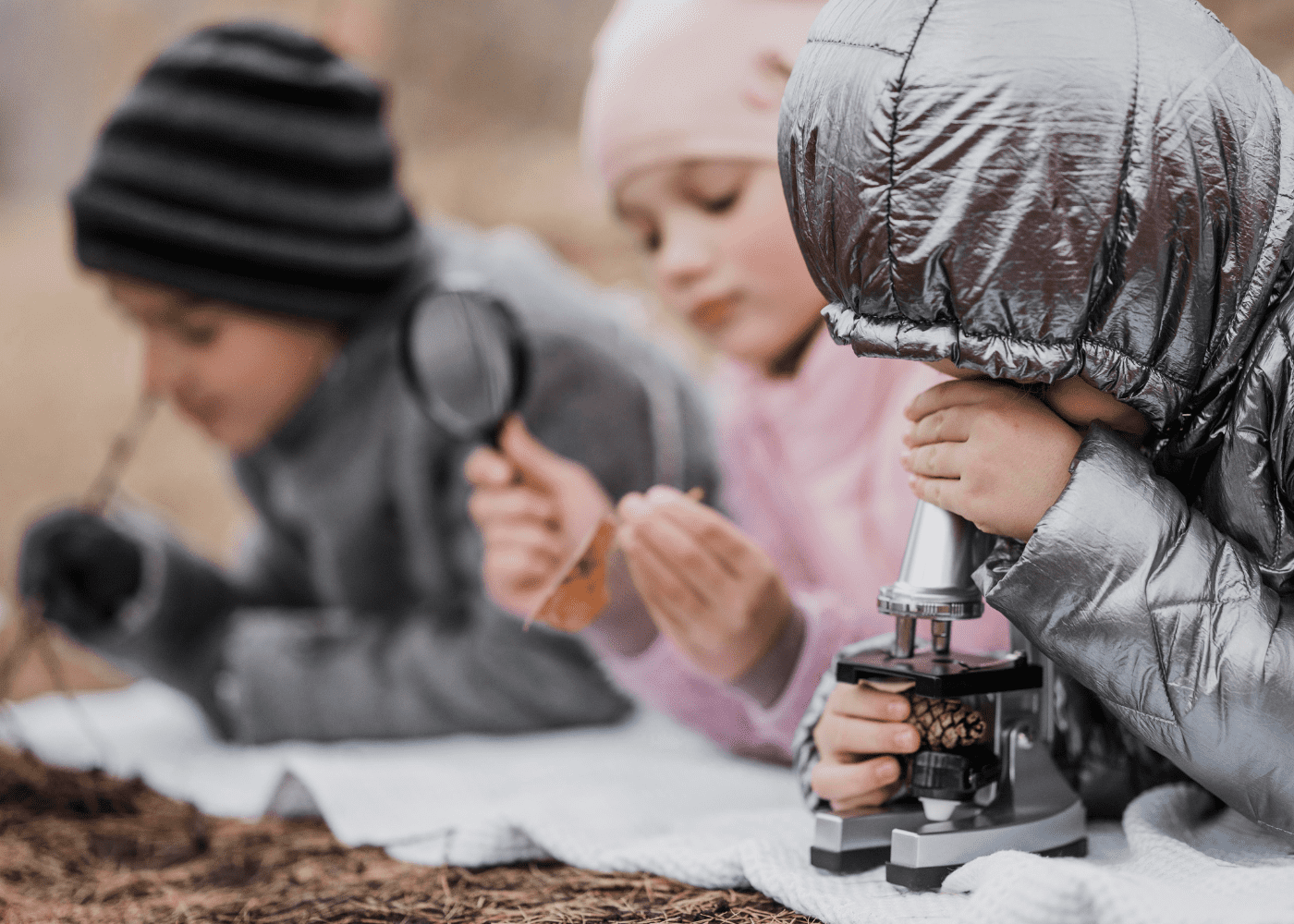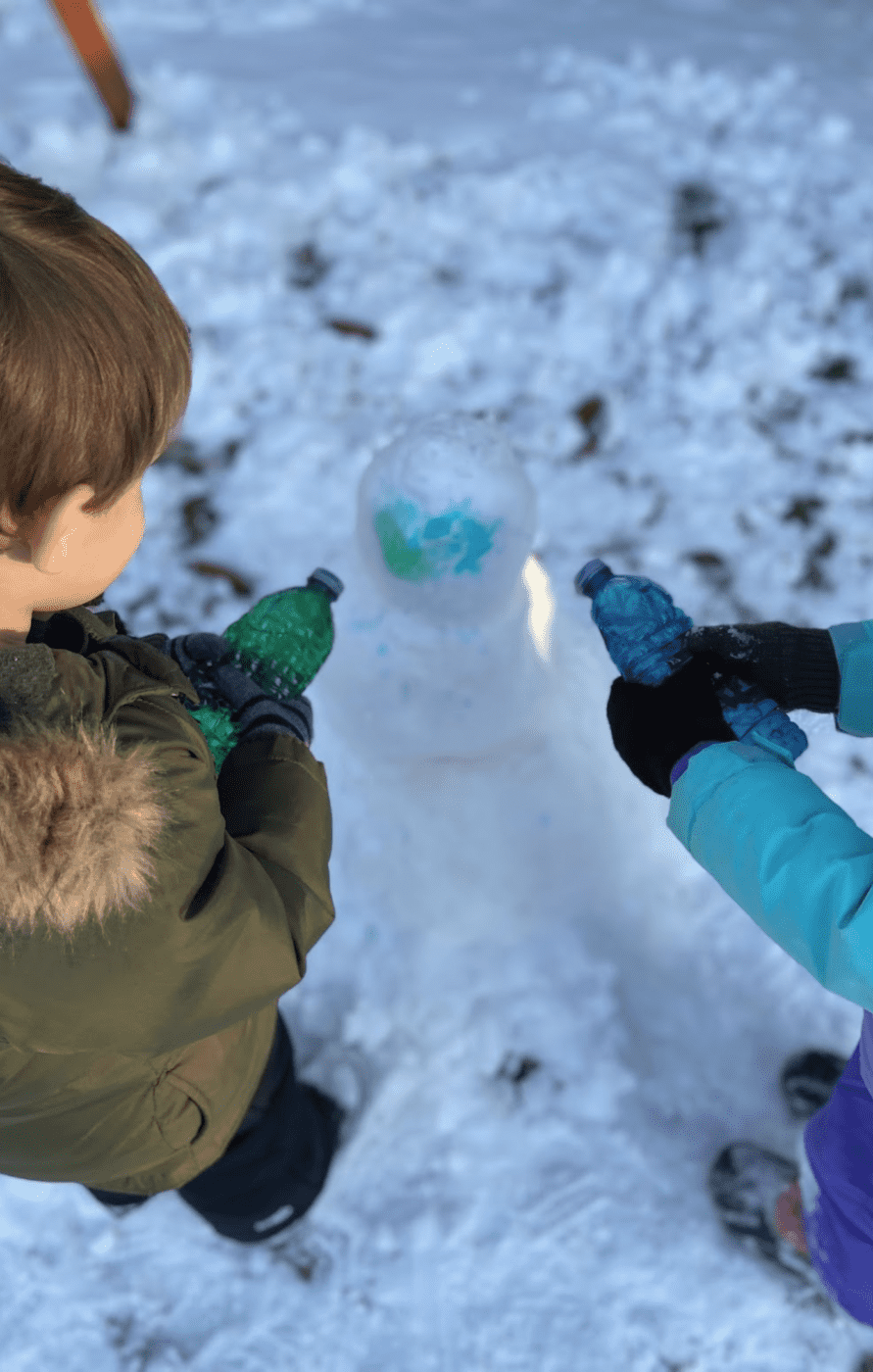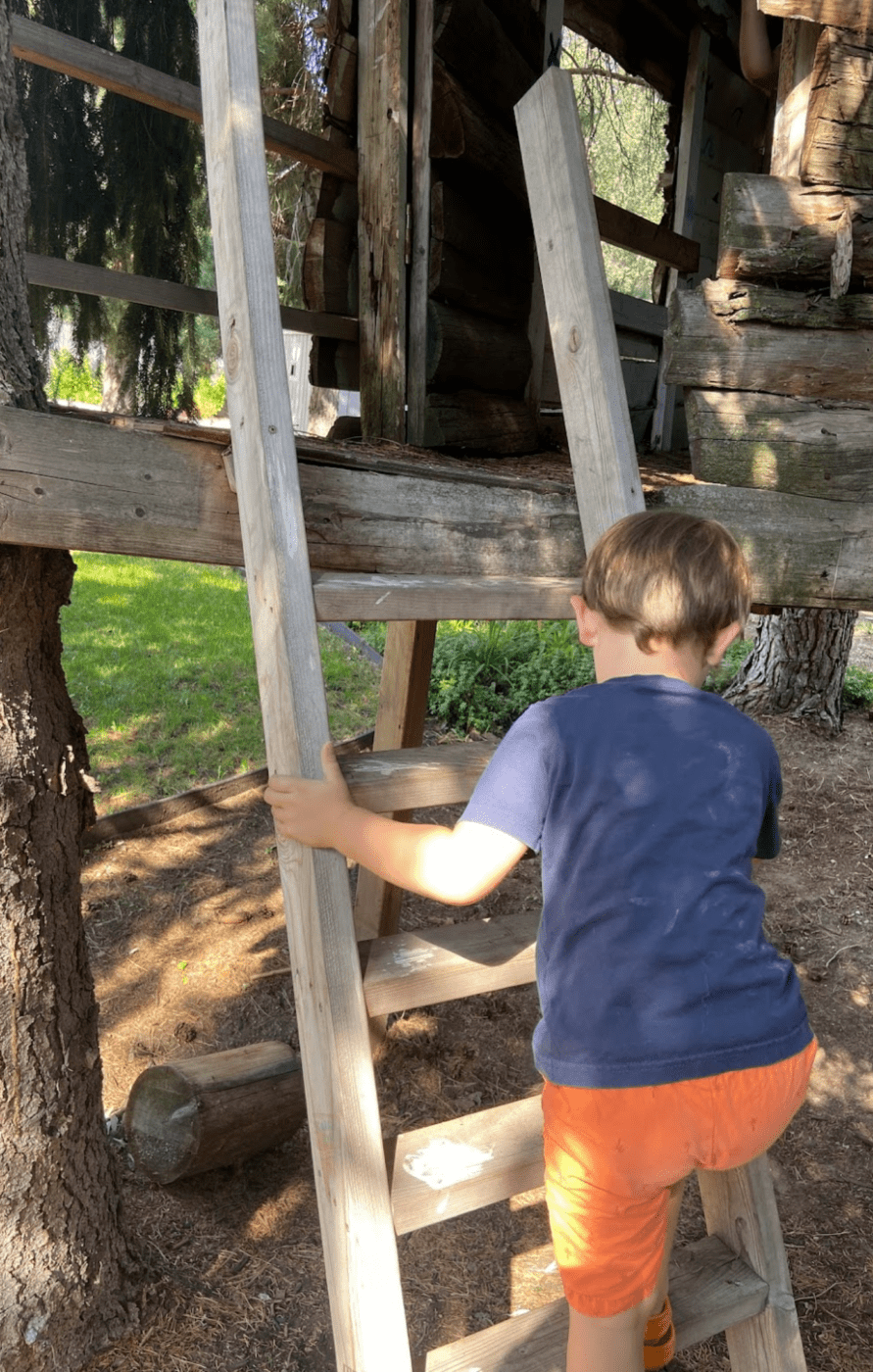Outdoor learning
Outdoor learning is a great way to teach school subjects like math and science while also encouraging children to explore and discover the world around them. Outdoor learning experiences also teach resilience, problem-solving skills, and sensory exploration... To name a few!
So, here are a few reasons why outdoor learning is important for your child’s development and ideas for promoting learning outside of traditional academic settings.

The benefits of outdoor learning
Outdoor learning offers a unique and valuable experience for children and students of all ages. Whether it’s a guided nature walk, an outdoor cooking class, or simply exploring the backyard, being outdoors can provide children with an opportunity to observe and marvel at the world around them.
These meaningful experiences build strong connections between the natural environment and themselves, allowing them to appreciate and understand the wonders of nature. These connections are especially important in today’s increasingly digital world, where we often find ourselves too busy to make time for outdoor experiences.
Scientifically, studies have shown strong evidence for the benefits of spending time outdoors. For example, Harvey et al. conducted a study to see the benefits of a hands-on outdoor learning initiative delivered in elementary schools. They found that even one hour a week of outdoor learning throughout the entire school year resulted in improved general well-being, mood, and connection to nature. Read the study here.
What I love about that research study is that they didn’t have a fancy outdoor classroom with expensive equipment. Their program was tailored to the school environment, making it adaptable for learning in urban settings too!
Outdoor learning has positive impacts for children – it works on their intrinsic motivation for learning, provides enjoyable lessons, increases creativity, and activates thinking outside the box. It also improves children’s health and wellbeing, social skills and behaviour, and furthermore has been proven to encourage better attendance, teamwork and to reduce bullying.
Nature Play QLD
Outdoor learning for all ages
It’s important to remember that time spent outside benefits everyone! It begins from infancy when babies enjoy stimulation from natural elements like sunlight or running water, enabling them to explore new sights, sounds and textures in a safe environment.
And most subjects can be taught outside! Check out my post, Ways to teach preschool in nature, to see how I teach mathematics outside.
By exposing children of all ages to outdoor learning environments, we can instill a deep respect for nature that will serve them throughout their lives. Many children are eager to learn outdoors, too, as this type of learning allows them to engage deeply with the world around them (and it’s fun!).

How to get started with outdoor learning
For those looking to incorporate outdoor learning into their curriculum or day-to-day learning, the possibilities are endless! It’s also important to remember that you can teach outside in many different ways. And, you can spend time outside no matter the season.
If you’re new to outdoor education, I would suggest first checking if there is an outdoor learning initiative already happening in your community or school. If not, try seeking out someone who has worked in an outdoor learning initiative similar to what you envision!
You don’t need to make a big field trip every time! School grounds have many nature-related lessons to be taught, and there are greenspaces in many communities that offer opportunities for learning. You could also check out local parks, or, if you can’t get outside, bring nature education indoors when you can. Remember never to harm the environment or take things you don’t need. And return nature to nature whenever you can.
The key to success lies in making a plan before getting started. Begin by assessing your local environment—which plants, animals, and other elements might be of interest? From there, determine the age group(s) you will be teaching and how much time they can spend outside.
With those factors in mind, start brainstorming activities to help children explore their surroundings and consider their interests. Consider bringing scavenger hunts to the park or beach, creating murals with natural materials such as flower petals or shells, or participating in backyard bird-watching, for example.
When it comes to outdoor learning, you’ll also need to remember to take everything with you and bring everything back. That being said, try to plan your activities with minimal items and think about everything you will need.
From there, plan outings that align with any local curricula guidelines or the subject you want to focus on. Outline an itinerary so all materials needed (and safety protocols observed) are followed while introducing new perspectives and experiences.
Finally, remember, above all else, to have fun! With some creative thinking and preparation, teachers, parents, and students alike can reap the benefits of outdoor learning. Through thoughtful planning and engaging activities, getting started with this exciting form of instruction can be both rewarding and inspiring!
Here’s a great introductory video for teaching outdoors (and how to anticipate challenges you may encounter when you teach outside):
Tips for making the most of outdoor learning
Outdoor learning can be an incredibly enriching experience for young students. Being able to experience nature first-hand and interact directly with their environment can help spark curiosity and enhance understanding in ways that traditional classroom instruction can’t quite accomplish.
For the teacher wanting to make the most of this type of learning, there are some important tips to consider. First and foremost, it’s important to plan activities that will be meaningful and engaging. Interactive games or challenges can help keep students focused and bring the material alive in a practical manner.
It is also crucial to have a well-defined purpose for each class session — why are you teaching what you’re teaching? A well-thought-out lesson plan should be created with purpose built into it.
Furthermore, choose a natural area with features specific to what you want your students to explore. Be sure everyone knows the boundaries before setting off so as not to enter areas with uneven terrain or dangerous wildlife. Have a specific call or signal for when you need children to pay attention to you or come back, and make sure to teach and practice this lots before learning outside.
Being well-prepared will help ensure your outdoor classes become productive learning experiences! Bring everything you need and be prepared to be flexible, as the outdoor classroom is much more predictable than the inside. You have to consider weather, distractions, and interruptions, for example.

The importance of safety when outdoor learning
Outdoor learning is a powerful tool for students of all ages, offering the firsthand experience of natural wonders and exciting opportunities to explore the world around them. However, for outdoor education to be successful, it’s important that everyone involved practice proper safety protocols.
One thing to always take into account is the weather! Make sure children are properly dressed so that they are not exposed to the elements. It’s better to remove layers than to need a jacket and not have one!
Even when participating in seemingly harmless activities such as nature hikes or bird watching, students must be suitably dressed and take precautions to avoid injury from weather conditions and unseen hazards.
Depending on the type of outdoor learning being undertaken, additional safety gear like helmets and lifejackets may be necessary. It’s also essential to clearly explain the risks and train participants on the appropriate way to behave while outdoors. Do your own risk assessment before taking little ones outside for outdoor play and learning.
All in all, with due care taken and proper protocols followed, outdoor learning can offer an invaluable opportunity for meaningful personal growth – but not if it comes at the cost of someone’s safety. By understanding its importance and taking every possible measure beforehand, you can look forward with confidence to a safe yet fulfilling experience outdoors.
The best resources for outdoor learning
Outdoor learning can be a great way for children (and adults!) to get in touch with nature and gain an appreciation for the world around them. For teachers, finding the best resources for outdoor learning can be challenging, but there are plenty of great options available.
Educators first need to identify their goals and objectives so that they can choose materials that complement their curriculum and lesson plans. Free or no-cost resources – like those from stewardship organizations or governmental bodies – often provide a wealth of helpful information without the cost of purchasing additional materials.
Books, movies, online videos, podcasts, and blogs are all good sources of helpful content when one is looking for ways to expand an outdoor learning activity. Lastly, community members and local experts can provide valuable insight into topics related to outdoor activities – especially when they bring an understanding of ecological systems or cultural practices that may not be widely known by other learners.
All these elements combined can create interesting and stimulating lessons that make it easier for people to connect with nature in meaningful ways! And look below in the resources section for some of our other articles about education outside.
Outdoor learning is a great way to get kids excited about education and the world around them. With so many benefits, from social-emotional learning to increasing academic performance, it’s no wonder that more and more schools are incorporating outdoor learning into their curriculum!

Conclusion
Environmental education has many benefits for kids, as it teaches them to practice empathy for the land and increases self-awareness and many other social skills. Being outside in the fresh air also has many benefits, which are felt by students and teachers alike!
Remember, an outdoor learning initiative does not have to mean big field trips! You can practice environmental education in any green space, or use urban settings to have conversations about the lack of nature. You can also get students out of their classrooms and learning in an outdoor space no matter the time of year. As long as you are well prepared, the students understand the expectations and boundaries, and you have. a clear goal in mind, classes can easily be taught outside.
If you are new to outdoor education, you may want to check out what is already happening in your school or in communities nearby. Chat with other families, teachers, and community partners to see if you can check out their programs or work together creating yours. You could also support a community organization by attending an event with students to see if they are interested in exploring the initiative!
FAQs
What is meant by outdoor learning?
Outdoor learning is any learning outside. Realistically, you can take any school subject and teach it outside! This includes art, math, science, social studies, etc.
Why is learning outside important?
Learning outside is important because it helps children develop a connection with nature and a deeper understanding of the world around them. Research has also found that it benefits health and wellbeing, too.
How do you improve outdoor learning?
Being prepared is very important in outdoor learning. Make sure to consider everything from the weather to unforeseen interruptions to your lessons, and plan accordingly. It is also important to discuss safety and set clear boundaries with learners.
Resources
Looking for more articles about outdoor learning? Here are some of the articles we have on the topic:
- Nature counting: Teach young learners how to count outside with these 10 nature counting activities!
- Nature art: Arts and crafts outside are lots of fun. Get 10 nature craft ideas in this post.
- Shadow drawing: Learn about shadows and create cool art outside!
- Physical education outdoors: Learn about the benefits of outdoor physical education in this post.
- 10 outdoor toys for 1-year-olds: Introducing a little one to the outdoors? See our favorite toys and activities here.
- Benefits of outdoor play for preschoolers: We talked about some the general benefits of outdoor learning in this post, but you can learn more details here.
- Time capsule ideas: What to include and how to plan
References
Psychological benefits of a biodiversity-focussed outdoor learning program for primary school children, by Deborah J. Harvey, Louise N. Montgomery, Hannah Harvey, Felix Hall, Alan C. Gange, and Dawn Watling
Outdoor learning & Other activities
Read more about our favorite activities, arts and crafts, coloring pages, and why we love learning outside!
